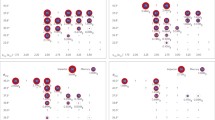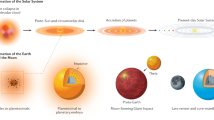Abstract
Mercury’s unusually high mean density has always been attributed to special circumstances that occurred during the formation of the planet or shortly thereafter, and due to the planet’s close proximity to the Sun. The nature of these special circumstances is still being debated and several scenarios, all proposed more than 20 years ago, have been suggested. In all scenarios, the high mean density is the result of severe fractionation occurring between silicates and iron. It is the origin of this fractionation that is at the centre of the debate: is it due to differences in condensation temperature and/or in material characteristics (e.g. density, strength)? Is it because of mantle evaporation due to the close proximity to the Sun? Or is it due to the blasting off of the mantle during a giant impact?
In this paper we investigate, in some detail, the fractionation induced by a giant impact on a proto-Mercury having roughly chondritic elemental abundances. We have extended the previous work on this hypothesis in two significant directions. First, we have considerably increased the resolution of the simulation of the collision itself. Second, we have addressed the fate of the ejecta following the impact by computing the expected reaccretion timescale and comparing it to the removal timescale from gravitational interactions with other planets (essentially Venus) and the Poynting–Robertson effect. To compute the latter, we have determined the expected size distribution of the condensates formed during the cooling of the expanding vapor cloud generated by the impact.
We find that, even though some ejected material will be reaccreted, the removal of the mantle of proto-Mercury following a giant impact can indeed lead to the required long-term fractionation between silicates and iron and therefore account for the anomalously high mean density of the planet. Detailed coupled dynamical–chemical modeling of this formation mechanism should be carried out in such a way as to allow explicit testing of the giant impact hypothesis by forthcoming space missions (e.g. MESSENGER and BepiColombo).
Similar content being viewed by others
References
J.D. Anderson, G. Colombo, P.B. Esposito, E.L. Lau, G.B. Trager, Icarus 71, 337 (1987)
A. Anic, PhD Thesis, University of Bern, 2006
A. Anic, W. Benz, J. Horner, J.A. Whitby, Icarus (2007, in preparation)
A. Balogh, R. Grard, S.C. Solomon, R. Schulz, Y. Langevin, Y. Kasaba, M. Fujimoto, Space Sci. Rev. (2007, this issue). doi:10.1007/s11214-007-9212-4
S.S. Barshay, J.S. Lewis, Annu. Rev. Astron. Astrophys. 14, 81 (1976)
W. Benz, in The Numerical Modelling of Nonlinear Stellar Pulsations Problems and Prospects, ed. by J.R. Buchler (1990), p. 269
W. Benz, A.G.W. Cameron, W.L. Slattery, Icarus 74, 516 (1988)
W. Benz, A.G.W. Cameron, H.J. Melosh, Icarus 81, 113 (1989)
W.F. Bottke, D.P. Rubincam, J.A. Burns, Icarus 145, 301 (2000)
A.G.W. Cameron, Icarus 64, 285 (1985)
A.G.W. Cameron, B. Fegley, W. Benz, W.L. Slattery, in Mercury, ed. by F. Vilas, C. Chapman, M.S. Matthews (University of Arizona Press, Tucson, 1988), 692 pp
J.E. Chambers, Mon. Not. R. Astron. Soc. 304, 793 (1999)
J.F. Elliot, M. Gleiser, V. Ramakrishna, in Thermochemistry for Steelmaking, vol. II (Addison-Wesley, 1963)
B. Fegley Jr., A.G.W. Cameron, Icarus 82, 207 (1987)
B. Fegley Jr., J.S. Lewis, Icarus 41, 439 (1980)
H.P. Gail, E. Sedlmayr, Astron. Astrophys. 166, 225 (1986)
B. Gladman, LPSC XXXIV, #1933 (2003)
K.A. Goettel, S.S. Barshay, in The Origin of the Solar System, ed. by S. Dermott (Wiley, Chichester, 1978), 611 pp
D.E. Grady, J.A.P. 53, 322–325 (1982)
H. Harder, G. Schubert, Icarus 151, 118 (2001)
J.S. Lewis, Earth Planet. Sci. Lett. 15, 286 (1972)
J.S. Lewis, Science 186, 440 (1974)
J.S. Lewis, in Mercury, ed. by F. Vilas, C. Chapman, M.S. Matthews (University of Arizona Press, Tucson, 1988), p. 651
E. Mediavilla, J. Buitrago, Eur. J. Phys. 10, 127 (1989)
H.J. Melosh, A.M. Vickery, Nature 350, 494 (1991)
P. Michel, W. Benz, P. Tanga, D. Richardson, Icarus 160, 448 (2002)
J.J. Monaghan, Annu. Rev. Astron. Astrophys. 30, 543 (1992)
J.P. Morris, J.J. Monaghan, J. Comput. Phys. 136, 41 (1997)
Y.P. Raizer, J. Exp. Theor. Phys. 37(6), 1229 (1960)
H.P. Robertson, Mon. Not. R. Astron. Soc. 97, 423 (1937)
E.M. Shoemaker, in Physics and Astronomy of the Moon, ed. by Z. Kopal (Academic, New York and London, 1962)
J.V. Smith, Mineral. Mag. 43, 1 (1979)
T. Spohn, F. Sohl, K. Wieczerkowski, V. Conzelmann, Phys. Space Sci. 49, 1561 (2001)
A. Sprague, J. Warell, G. Cremonese, Y. Langevin, J. Helbert, P. Wurz, I. Veselovsky, S. Orsini, A. Milillo, Space Sci. Rev. (2007, this issue). doi:10.1007/s11214-007-9221-3
H.S. Thompson, S.L. Lauson, Sandia Labarotories Report SC-RR-710714 (1984)
H.C. Urey, Geochim. Cosmochim. Acta 1, 209 (1951)
H.C. Urey, The Planets (Yale University Press, New Haven, 1952)
J. Warrel, O. Karlsson, E. Skoglov, Astron. Astrophys. 411, 291 (2003)
S.J. Weidenschilling, Icarus 35, 99 (1978)
G.W. Wetherill, in Origin of the Moon, ed. by W.K. Hartmann, R.J. Phillips, G.J. Taylor (Lunar and Planetary Institute, Houston, 1986), 519 pp
S.P. Wyatt Jr., F.L. Whipple, Astrophys. J. 111, 134 (1950)
Author information
Authors and Affiliations
Corresponding author
Rights and permissions
About this article
Cite this article
Benz, W., Anic, A., Horner, J. et al. The Origin of Mercury. Space Sci Rev 132, 189–202 (2007). https://doi.org/10.1007/s11214-007-9284-1
Received:
Accepted:
Published:
Issue Date:
DOI: https://doi.org/10.1007/s11214-007-9284-1




